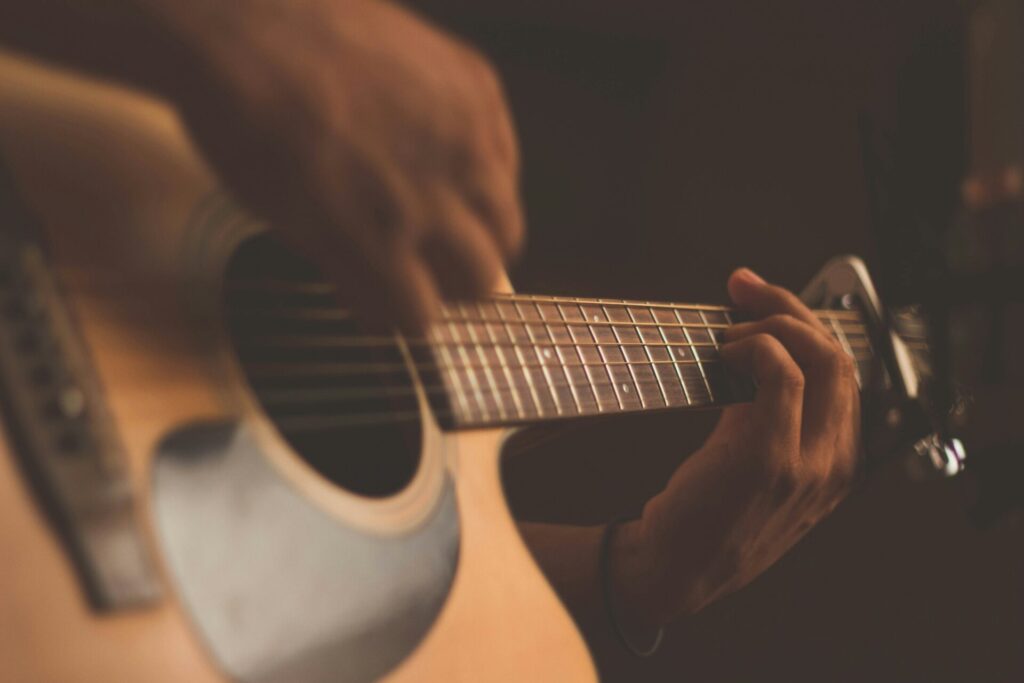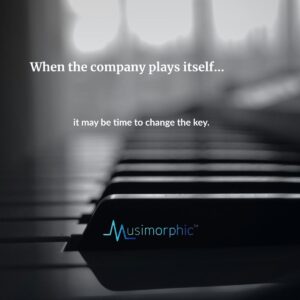Why is is that playing the guitar lowers symptoms of post-traumatic stress in military Veterans? Is there something about the music, the vibration, the immersion, the intention, or the belief (that playing the guitar lowers symptoms of post-traumatic stress)?
Simply put: yes.
This post explores the theory that choosing a more immersive experience helps change post-traumatic stress to post-traumatic growth. It also postulates that immersion and belief play significant roles in the relief of symptoms and actual physiological transformation that results from skillful use of music, both making it and listening to it.
Science!
The claims made by Guitars for Vets are real and supported by research. I was there as a volunteer instructor and program facilitator for several hundred military Veterans who found solace that no other modality had given them.
Because Musimorphic™ programs are listening-based as well as playing-based, both the Guitars for Vets research and my observed real-life results served to further convince me that there is much more to music than we often give it credit for, particularly in the therapeutic sense. Music has saved my life more than once, and the only thing I brought to those experiences was a willingness to listen until the miracle happened and an openness to transformation instead of resignation.
What is it that makes music effective for relief of post-traumatic stress symptoms for participants in Guitars for Vets? Do people in a symphony audience of stadium concert experience the same relief? What are the markers of a “successful” guitar player or listener, if listening can have a similar benefit?
The Educated Guess
Guitars for Vets is just the tip of the iceberg. Thanks to the vision of Maestro Jahja Ling, music director emeritus of the San Diego Symphony, I have watched thousands of military veterans experience relief simply listening to music with intent. Maestro Ling’s standing invitation to not-for-profits and agencies serving military veterans was specific in precisely the way that elevated the transformative power of symphonic music. How? Veterans and their family members were simply invited to attend concerts, at no cost except their time, to “experience relief.”
It only took two words to set expectations for any given concert: experience relief.
No need to quote the research, make logical arguments, or persuade anyone. People who show up with expectations are already on the road to relief. Why? Because beliefs matter.
Beliefs Matter
No need to elaborate on this. Beliefs are very important to human beings. They help ground us, connect us in community with one another, and guide our thoughts and actions. So what do we believe about music?
At the foundational level, we believe the research. We also believe the experts who write about their research in books such as “This Is Your Brain On Music.” We marvel at how ultrasound safely kills cancer cells, or the low tone of 40Hz (it’s nearly a low E or “E1” on a piano keyboard) helps stall the formation of plaque in the brain and promotes brain health. Research like that invites us to a deeper appreciation of music.
Flipping from the provable to the theoretical, there are many of us who believe in the power of specific vibrations (I’ve written about that before: see this post). What effect does belief have on results? How can we use any of this now?
First, we need to consider intention.
Setting the Intention
Listening to 40Hz has demonstrable evidence of being good, right? That evidence can be persuasive, enough that one would want to spend quite a lot of time with 40Hz to receive the benefits. This intention, informed by research, is another component of everything we do at Musimorphic™.
Why?
The evidence in support of setting intentions is also gaining support in the research community, even as we recall how outcomes are subject to the measurement limits of “observer bias.” If you give it some thought, you’ll discover how Intentions are often embodied in music: outcomes are frequently and specifically integrated into the song lyrics. Look no further than your favorite love song for an example of this. Musicologists, however, have documented how even the most ancient music was intended for far more than audible enjoyment.
Let’s ask the obvious question: if you are traumatized and have seen and believe the research about how playing a guitar can relieve symptoms of your trauma, wouldn’t you set an intention to learn to play the guitar and expect relief?
Or, if you have seen the research on how music and intention combine to improve results, would you jump for that? There is already research out there that demonstrates how this is so! The Bonny Method of Guided Imagery with Music has been around since the early 1990s, is part of the music therapy curriculum in many universities that offer such as degree, and has been recognized in research by the National Center for PTSD, the National Institutes of Health, and the American Psychological Association. Even better, the Bonny Method doesn’t care if you play an instrument or not: results are yours for the intending.
Case Study
A traumatized military Veteran dealing with substance abuse and mental wellness is also a guitar-playing musician. He tells me that music — playing and performing his own songs — keeps him mostly sober and sane. I can watch that happening in real time since I’m also the keyboard player in his cover band. With music, he’s good; remove the music, and he falls back into old patterns. His “best” life is busking to support his habit and, when all is said and done, this is his intention. It gives him a sense of relief. Would you call that success? For this man, it is. He is mostly sane, mostly safe, and mostly productive — that is, people who take joy in his performance give back to him in ways that we musicians value greatly. Is he totally free of post-traumatic stress symptoms? To the extent required to live a functional, purposeful and meaningful life, yes.
Post Traumatic Growth
As the ancient Buddhist practice of “tonglen” demonstrates, our human systems have the ability to accept, digest, and transform trauma. In fact, post-traumatic growth research also “admits” that there is as yet very little scientific evidence for why this works, in spite of the measurable facts that it works remarkably well. So how do we develop a practice of post-traumatic growth?
It begins by safely engaging the traumatic memory. That is, it a particular song is a trauma trigger for me, while I might have a elevated affect as I hear that song, if I can do so in safety (you can decide what that means as it is quite individual) and perhaps with support from a qualified therapist, my human system will, through repeated engagement with the triggered traumatic memory, “digest” that memory to remove the negative, traumatic charge. While the research is based in the trauma field, this process also describes my experience of allowing the suicidal thoughts and their resolution.
The power of releasing or transforming traumatic memory — from stress-inducing to growth-encouraging — is one that we can observe in many ways. From childhood to advanced age, we are continually offered opportunities to release rather than retain the troubles that ail us. in fact, psychologists generally agree that our ability to retain “the bad stuff” isn’t good for us. Wouldn’t a way to digest and release all that bad stuff be a good thing? Tonglen has been a practice for centuries; it’s the real-life tried and true version of the post-traumatic growth outcomes just now being investigated by modern research.
What About You?
So, how deeply are you able to engage your music? That’s a function of both belief and intention (or desire). If you want music to help you in some way, that’s a much more powerful intention than showing up at the symphony because your spouse made you go, right? Intentions engage us more deeply.
What do you believe about music? If you have a vague awareness of what music can do — “the power of music” — you’re on the right road. If you understand the research, that’s even better. Evidence in support of one’s beliefs is powerful: whether you ask a religious believer or a researcher, you’ll quickly learn about the affection they have for what they believe. Does it matter that there is comparatively little scientific evidence for religious dogma? Not to the believer!
We have shown you that evidence is important, that beliefs matter, and that intentions matter to the results you want. What remains?
What if you had a musical practice that was both research- and belief-informed? What if that practice combined intentions and music in a way that leveraged your potential? Well, I’m about to blow your mind: the research into post-traumatic stress strongly suggests that you need a practice like that.
Among the other things we do as coaches and consultants, Musimorphic ™ teaches deeper engagement with music. That’s fundamental to unlocking its power. We also teach how setting intentions with that more-deeply-engaged experience of music can be transformative. For myself, my experience convinces me that practices like this are powerful, safe, and effective, do not require clinical supervision, and work whether the music is audible or remembered.
And there’s more: the same musical practice process that digests trauma can be employed to strengthen friendships, resolve conflict, and embrace paradox. Personal development comes into focus with music. A more genuine compassion is possible with music. In short, whatever inspires you to grow and whatever your direction in life may be, music can support that. Musical wallpaper? It’s nice, but it’s still in the background when it comes to your active engagement.
If this interests you even a little, please accept my invitation: experience it for yourself. Let’s do a Musimorphic™ session together. It’s not expensive, compared to the results you’ll enjoy. Questions? Reach out to me via email: musimorphic@gmail.com.
Schedule a Musimorphic Session
I look forward to that!
Bill Protzmann has rediscovered the fundamental nature and purpose of music and accumulated a vast awareness of anthropology and sociology, as well as the effects of music, the arts, and information technology on human beings. Bill has experimented with what he has learned through performing concerts, giving lectures, facilitating workshops, and teaching classes. He first published on the powerful extensibility of music into the business realm in 2006 (here and abstract here). Ten years later, in 2016, he consolidated his work into the Musimorphic Quest. In this guided, gamified, experiential environment, participants discover and remember their innate connection to this ancient transformative technology. The National Council for Behavioral Healthcare recognized Bill in 2014 with an Inspiring Hope award for Artistic Expression, the industry equivalent of winning an Oscar.
In addition to individuals, Musimorphic programs support personal and professional development and wellness for businesses, NPOs and at-risk populations.



